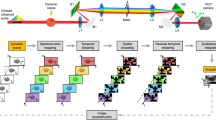Abstract
Terahertz (THz) radiation probes intermolecular interactions through crystal lattice vibrations, allowing the characterization of solid materials1,2. Thus, THz spectroscopy is a promising alternative to mainstream solid-state analytical tools such as X-ray diffraction or thermal analysis3. The method provides the benefits of online measurement4, remote sampling5 and three-dimensional imaging6, all of which are attractive for quality control and security applications. In the context of pharmaceutical solids, THz spectroscopy can differentiate and quantify different forms of active pharmaceutical ingredients7,8. Here, we apply this technique to monitor a dynamic process involving two molecular crystals9. In particular, we follow the mechanochemical construction of a two-component cocrystal10,11,12 by grinding together phenazine (phen) and mesaconic acid (mes)13. To rationalize the observed changes in the spectra, we conduct lattice dynamics calculations that lead to the tentative assignment of at least one feature in the cocrystal THz spectrum.
This is a preview of subscription content, access via your institution
Access options
Subscribe to this journal
Receive 12 print issues and online access
$259.00 per year
only $21.58 per issue
Buy this article
- Purchase on Springer Link
- Instant access to full article PDF
Prices may be subject to local taxes which are calculated during checkout




Similar content being viewed by others
References
Chamberlain, J. M. Where optics meets electronics: Recent progress in decreasing the terahertz gap. Phil. Trans. R. Soc. Lond. A 362, 199–213 (2004).
Han, J., Xu, H., Zhu, Z., Yu, X. & Li, W. Terahertz spectroscopy of naphthalene, alpha-naphthol, beta-naphthol, biphenyl and anthracene. Chem. Phys. Lett. 392, 348–351 (2004).
Shah, B., Kakumanu, V. K. & Bansal, A. K. Analytical techniques for quantification of amorphous/crystalline phases in pharmaceutical solids. J. Pharm. Sci. 95, 1641–1665 (2006).
Fischer, B., Hoffmann, M., Helm, H., Modjesch, G. & Jepsen, P. U. Chemical recognition in terahertz time-domain spectroscopy and imaging. Semicond. Sci. Technol. 20, S246–S253 (2005).
Deibel, J. A., Wang, K., Escarra, M. D. & Mittleman, D. M. Enhanced coupling of terahertz radiation to cylindrical wire waveguides. Opt. Express 14, 279–290 (2006).
Nguyen, K. L. et al. Three-dimensional imaging with a terahertz quantum cascade laser. Opt. Express 14, 2123–2129 (2006).
Strachan, C. J. et al. Using terahertz pulsed spectroscopy to quantify pharmaceutical polymorphism and crystallinity. J. Pharm. Sci. 94, 837–846 (2005).
Upadhya, P. C. et al. Characterisation of crystalline phase transformations in theophylline by time domain terahertz spectroscopy. Spectrosc. Lett. 39, 215–224 (2006).
Liu, H.-B. & Zhang, X.-C. Dehydration kinetics of D-glucose monohydrate studied using THz time-domain spectroscopy. Chem. Phys. Lett. 429, 229–333 (2006).
Vishweshwar, P., McMahon, J. A., Bis, J. A. & Zaworotko, M. J. Pharmaceutical co-crystals. J. Pharm. Sci. 95, 499–516 (2006).
Sokolov, A. N., Friščić, T. & MacGillivray, L. R. Enforced face-to-face stacking of organic semiconductor building blocks within hydrogen-bonded molecular cocrystals. J. Am. Chem. Soc. 128, 2806–2807 (2006).
Smolka, T., Schaller, T., Sustmann, R., Bläser, D. & Boese, R. Structure and properties of cocrystals of phenazine and fumaric, 2,3-dihydroxyfumaric and oxalic acid. J. Prakt. Chem. 342, 465–472 (2000).
Batchelor, E., Klinowski, J. & Jones, W. Crystal engineering using co-crystallisation of phenazine with dicarboxylic acids. J. Mater. Chem. 10, 839–848 (2000).
Steiner, T. The hydrogen bond in the solid state. Angew. Chem. Int. Edn 41, 48–76 (2002).
Walmsley, S. H. Lattice vibrations and elastic constants of molecular crystals in the pair potential approximation. J. Chem. Phys. 48, 1438–1444 (1968).
Day, G. M., Zeitler, J. A., Jones, W., Rades, T. & Taday, P. F. Understanding the influence of polymorphism on phonon spectra: Lattice dynamics calculations and terahertz spectroscopy of carbamazepine. J. Phys. Chem. B 110, 447–456 (2006).
Luty, T. & Munn, R. W. Infrared intensities of lattice vibrations in molecular crystals. Chem. Phys. 43, 295–302 (1979).
Trask, A. V. & Jones, W. Crystal engineering of organic cocrystals by the solid-state grinding approach. Top. Curr. Chem. 254, 41–70 (2005).
Allis, D. G., Prokhorova, D. A. & Korter, T. M. Solid-state modeling of the terahertz spectrum of the high explosive HMX. J. Phys. Chem. A 110, 1951–1959 (2006).
Acknowledgements
We are grateful to the Research Councils UK ‘Basic Technology Programme’ for funding aspects of this work. K.L.N. thanks the Gates Cambridge Trust for financial support. T.F. acknowledges the Pfizer Institute for Pharmaceutical Materials Science for funding. G.M.D. thanks the Royal Society for funding.
Author information
Authors and Affiliations
Contributions
All authors contributed to the analysis and interpretation of the results. Sample preparation and measurements were carried out by K.L.N. and T.F. The computational work of predicting and interpreting the form of the spectra was done by G.M.D.
Corresponding authors
Ethics declarations
Competing interests
The authors declare no competing financial interests.
Supplementary information
Supplementary Information
Supplementary figures S1-S6 (PDF 2178 kb)
Rights and permissions
About this article
Cite this article
Lien Nguyen, K., Friščić, T., Day, G. et al. Terahertz time-domain spectroscopy and the quantitative monitoring of mechanochemical cocrystal formation. Nature Mater 6, 206–209 (2007). https://doi.org/10.1038/nmat1848
Received:
Accepted:
Published:
Issue Date:
DOI: https://doi.org/10.1038/nmat1848
This article is cited by
-
Frequency selective fingerprint sensor: the Terahertz unity platform for broadband chiral enantiomers multiplexed signals and narrowband molecular AIT enhancement
PhotoniX (2023)
-
Twisting, untwisting, and retwisting of elastic Co-based nanohelices
Nature Communications (2023)
-
Investigating the function and design of molecular materials through terahertz vibrational spectroscopy
Nature Reviews Chemistry (2023)
-
Mechanochemical synthesis, thermoanalytical study and characterization of new multicomponent solid forms of norfloxacin with saccharin
Journal of Thermal Analysis and Calorimetry (2022)
-
Characterization of a Pentagonal CSRR Bandpass Filter for Terahertz Applications
Journal of Electronic Materials (2022)



